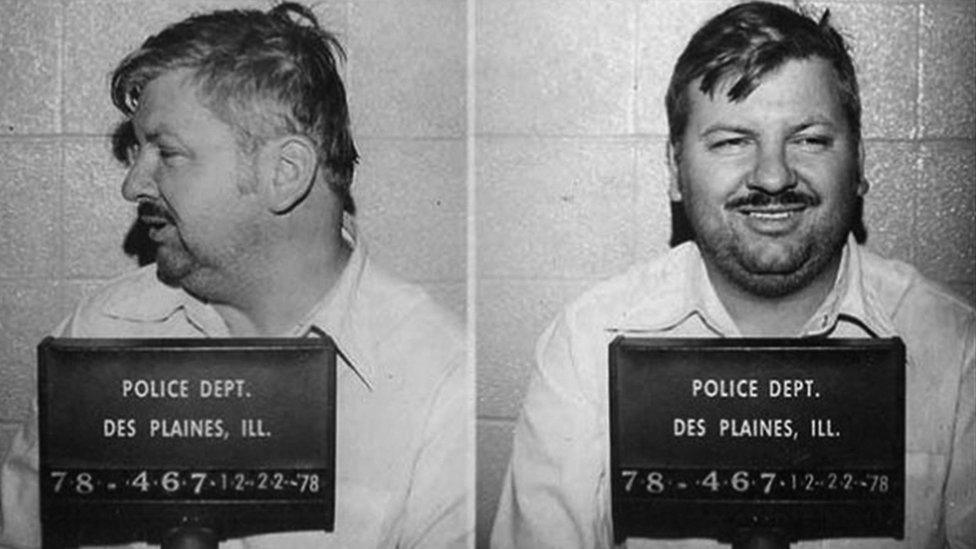Who Was John Wayne Gacy? America’s Most Notorious Serial Killer
John Wayne Gacy (March 17, 1942 – May 10, 1994) stands as one of the most notorious serial killers in American history, convicted of murdering 33 young men and boys between 1972 and 1978 in the Chicago area. Known as the “Killer Clown” due to his performances as “Pogo the Clown” at children’s parties and charity events, Gacy’s horrific double life shocked the nation and forever changed how law enforcement investigates missing persons cases.
Early Life and Background
Born in Chicago, Illinois, John Wayne Gacy grew up in a troubled household with an alcoholic, abusive father. Despite his difficult childhood, he appeared to lead a normal adult life:
- Career: Successful contractor running PDM Contractors
- Community involvement: Active in local Democratic politics
- Public persona: Entertained children as Pogo the Clown at hospitals and community events
- Social status: Well-regarded businessman and community member
This carefully constructed facade made Gacy seem beyond suspicion—a reality that would have deadly consequences for dozens of young victims.
Criminal History Before the Murders
According to Wikipedia, Gacy had a prior criminal conviction that should have raised red flags:
1968: Convicted of sexually abusing a teenage boy in Waterloo, Iowa
- Sentenced to 10 years in prison
- Released on parole after serving only 18 months
- Successfully hid his criminal record from friends, neighbors, and business associates
This early release and ability to conceal his past created the perfect conditions for his subsequent killing spree.
The Killer Clown’s Crimes: How Gacy Operated {#the-killer-clowns-crimes}
Modus Operandi
John Wayne Gacy developed a calculated and horrifying method for targeting, capturing, and murdering his victims:
1. Target Selection
- Young men and teenage boys (ages 14-21)
- Vulnerable youth, including runaways and those from working-class backgrounds
- Individuals seeking employment opportunities
2. Luring Victims
- Offered jobs at his construction company with attractive wages ($5 per hour—nearly double what many could earn elsewhere)
- Used his respectable community standing to gain trust
- Targeted young men at bus stations, malls, and through his construction business
3. The “Magic Trick”
- Would invite victims to his home
- Performed a “magic trick” demonstration involving handcuffs
- Once restrained, victims were tortured, sexually assaulted, and murdered
- Primary method of killing: strangulation with a garrote or asphyxiation
4. Body Disposal
- 26 victims buried in the crawl space beneath his ranch-style house
- 3 victims buried elsewhere on his property
- 4 victims discarded in the Des Plaines River
The Scope of His Crimes
At the time of his conviction in 1980, Gacy’s 33 murders represented the highest number of homicides by one individual in United States legal history. However, Gacy himself claimed the total could be as high as 45 victims, though only 33 were ever definitively linked to him.

Victims of John Wayne Gacy: Remembering the Lost Lives
Identified Victims
Many of John Wayne Gacy’s victims have been identified through DNA testing and forensic genealogy, with recent identifications continuing as technology advances:
Confirmed Victims Include:
- Timothy Jack McCoy
- John Butkovich
- Francis Wayne Alexander (identified via forensic genealogy in October 2021)
- Darrel Samson
- Samuel Stapleton
- Randall Reffett
- Michael Bonnin
- William Carroll
- Jimmy Haakenson
- Rick Johnston
- William George Bundy (identified through DNA testing in November 2011)
- Kenneth Parker
- Gregory Godzik
- John Szyc
- Jon Prestidge
- Matthew Bowman
- Robert Gilroy
- John Mowery
- Russell Nelson
- Robert Winch
- Tommy Boling
- David Talsma
- Bill Kindred
- Timothy O’Rourke
- Frank Landingin
- James Mazzara
- Robert Piest (final victim, age 15)
The Final Victim: Robert Piest
Robert “Rob” Piest, a 15-year-old high school student, became Gacy’s final victim on December 11, 1978. His disappearance directly led to Gacy’s arrest and the discovery of his crimes.
Rob told his mother, Elizabeth Piest, that he wanted to speak with a contractor about a job opportunity at the Nisson Pharmacy where he worked. When he didn’t return, Elizabeth immediately reported him missing—a decision that would ultimately bring Gacy to justice.
Ongoing Victim Identification
As of 2025, several victims remain unidentified. In 2012, the DNA of Gacy and other executed Illinois inmates was entered into a national DNA database to establish potential forensic links to further unsolved murders and identify remaining victims.
Investigation and Arrest: How the Killer Clown Was Caught
Timeline of Missed Opportunities
One of the most disturbing aspects of the Gacy case is the numerous opportunities law enforcement had to stop him before his final victim:
1975: Teenagers reported to police that a man named “John” was approaching young men and offering them jobs
1976:
- Police surveilled Gacy’s home in connection with a missing 9-year-old boy
- Investigation terminated without results
- Police questioned Gacy about the disappearance of 17-year-old Gregory Godzik, who had worked for him
1978: Chicago police arrested Gacy after a 19-year-old man reported being kidnapped and raped at gunpoint—yet Gacy continued operating freely
The Investigation That Broke the Case
The disappearance of Robert Piest triggered an investigation led by:
- Detective Rafael Tovar (Des Plaines Police Department)
- Detective Joe Kozenczak (Des Plaines Police Department)
- Lieutenant Joseph Kozenczak
When investigators obtained a search warrant for Gacy’s home, they discovered:
- A film receipt from Rob Piest’s coat pocket
- Syringes and drugs
- Other disturbing evidence
Further investigation uncovered Gacy’s prior conviction for sexual abuse. The discovery of bodies beneath his home shocked the nation and revealed the true extent of his crimes.
Trial and Execution
Prosecution: Led by William J. “Bill” Kunkle Jr., who served as chief trial prosecutor
Verdict: Found guilty of 33 murders in 1980
Sentence: Death penalty
Execution: May 10, 1994, by lethal injection at Stateville Correctional Center
BREAKING 2025 NEWS: Peacock’s “Devil in Disguise: John Wayne Gacy”
New Limited Series Premieres October 2025
According to NBC and Variety, Peacock premiered an eight-episode limited series titled “Devil in Disguise: John Wayne Gacy” on October 16, 2025.
A Victim-Centered Approach to True Crime
Unlike many sensationalized serial killer narratives, this series takes a revolutionary approach by prioritizing victims and their families over the killer himself.
Key Cast Members:
- Michael Chernus (“Severance”) as John Wayne Gacy
- Gabriel Luna (“The Last of Us”) as Detective Rafael Tovar
- James Badge Dale (“1923”) as Detective Joe Kozenczak
- Marin Ireland (“The Irishman”) as Elizabeth Piest
- Michael Angarano (“Oppenheimer”) as Sam Amirante (Gacy’s defense attorney)
- Chris Sullivan (“This Is Us”) as William J. “Bill” Kunkle Jr. (prosecutor)

What Makes This Series Different
According to Roger Ebert’s review, showrunner Patrick Macmanus (veteran of “Dr. Death” and “The Girl From Plainville”) made deliberate choices to avoid exploitation:
✓ No graphic violence shown on screen
✓ Only one brief shot of Gacy in clown makeup (from behind)
✓ Each episode concludes with photographs of the real victims
✓ Extensive focus on investigation and families’ experiences
✓ Emphasis on systemic failures that enabled the crimes
Critical Acclaim and Audience Response
The series has earned strong reviews:
- IMDb Rating: 8.1/10
- Critics praise Michael Chernus’s portrayal of Gacy’s psychotic tendencies through dialogue rather than graphic depiction
- Audiences appreciate the respectful, victim-focused approach
Production Details
Showrunner Patrick Macmanus and his team went to extraordinary lengths to honor victims:
- Contacted victims’ families directly for their perspectives
- Recreated Gacy’s house with meticulous detail
- Writer Yasamine Almanaseer suggested ending episodes with victim photos
Season 2 Announcement
Peacock has announced that “Devil in Disguise” will become an anthology series, with Season 2 focusing on Richard Ramirez, the “Night Stalker” who terrorized Los Angeles and Southern California in the mid-1980s.
Where to Watch
All eight episodes of “Devil in Disguise: John Wayne Gacy” are now streaming exclusively on Peacock.
Systemic Failures That Enabled a Serial Killer
Why Gacy Got Away With Murder for So Long
The John Wayne Gacy case exposed critical flaws in the criminal justice system of the 1970s:
1. Lack of Inter-Departmental Communication Different police departments failed to share information about missing persons and suspicious activities, preventing them from connecting the dots earlier.
2. Widespread Homophobia Many victims were assumed to be runaways or engaged in what authorities dismissively called “rough horseplay.” Prejudice against gay men led to missing persons cases being deprioritized.
3. Class Bias Many victims came from working-class or troubled backgrounds, making them less of a priority for law enforcement.
4. Early Prison Release Despite a serious conviction for sexual abuse of a minor, Gacy was released early, allowing him to continue his crimes.
5. Societal Trust in “Upstanding Citizens” Gacy’s community standing, business success, and political connections made him seem beyond suspicion.
Lessons for Modern Law Enforcement
The Gacy case remains relevant in 2025 for several critical reasons:
- Importance of taking every missing person report seriously
- Need for coordinated databases and inter-agency communication
- Addressing systemic biases that affect investigations
- Proper vetting and monitoring of sex offenders
- Victim advocacy regardless of background or lifestyle

Related True Crime Content
Other Serial Killer Cases in the USA
If you’re interested in the John Wayne Gacy case, you may also want to learn about other notorious serial killers:
- Ted Bundy – Murdered 30+ young women in the 1970s
- Jeffrey Dahmer – Milwaukee cannibal who killed 17 young men
- Dennis Rader (BTK Killer) – Bound, tortured, and killed 10 people over three decades
- Samuel Little – Most prolific serial killer in U.S. history with 93 confessed murders
- Richard Ramirez (Night Stalker) – Coming to “Devil in Disguise” Season 2
True Crime Documentaries About Gacy
For those wanting to learn more about John Wayne Gacy:
“Conversations with a Killer: The John Wayne Gacy Tapes” (Netflix, 2022)
- Features 60 hours of previously unreleased recordings with Gacy’s legal defense team
- Interviews with investigators, prosecutors, and survivors
- Directed by Joe Berlinger
“John Wayne Gacy: Devil in Disguise” (Peacock, 2021)
- Docuseries examining Gacy’s crimes
- Not to be confused with the 2025 scripted series
FAQs About John Wayne Gacy
How many people did John Wayne Gacy kill?
A jury convicted John Wayne Gacy of murdering 33 young men and boys between 1972 and 1978. However, Gacy himself claimed the total could be as high as 45 victims. Only 33 murders were ever definitively linked to him through evidence and remains found at his property.
Why was John Wayne Gacy called the Killer Clown?
People nicknamed Gacy the “Killer Clown” because he performed as “Pogo the Clown” at children’s parties, charity events, and hospitals before anyone discovered his crimes. He also collected and painted clown-themed artwork. The contrast between his wholesome public persona and his horrific crimes made the “Killer Clown” moniker particularly chilling.
Where did John Wayne Gacy live?
John Wayne Gacy lived in a ranch-style house in Norwood Park Township, a suburb of Chicago, Illinois. He committed all his known murders inside this home and buried 26 of his victims in the crawl space beneath it. The house was demolished in April 1979 following the extensive investigation.
How was John Wayne Gacy caught?
Police caught Gacy after 15-year-old Robert Piest disappeared on December 11, 1978. Robert’s mother, Elizabeth Piest, immediately reported him missing after he went to speak with Gacy about a job opportunity. Police investigation led to a search warrant for Gacy’s home, where they discovered evidence linking him to multiple murders. The subsequent excavation revealed bodies buried beneath his house.
When was John Wayne Gacy executed?
John Wayne Gacy was executed by lethal injection on May 10, 1994, at Stateville Correctional Center in Illinois. He was 52 years old. He had been on death row since his conviction in 1980.
Are all of John Wayne Gacy’s victims identified?
No, not all victims have been identified. While many have been identified through DNA testing and forensic genealogy (including recent identifications like Francis Wayne Alexander in 2021), several victims remain unidentified as of 2025. Efforts continue to identify the remaining victims using modern DNA technology and forensic genealogy techniques.
What happened to John Wayne Gacy’s house?
Investigators completed their extensive excavation of Gacy’s property in April 1979 and then demolished his house. The site where his house once stood has since been redeveloped, and a new home now occupies the location.
Did John Wayne Gacy have a family?
Yes, Gacy was married twice. His first marriage was to Marlynn Myers in 1964, with whom he had two children (a son and daughter). They divorced after his 1968 conviction for sexual abuse. He married his second wife, Carole Hoff, in 1972 and became stepfather to her two daughters. They divorced in 1976 as his crimes escalated.
What serial killers were active at the same time as John Wayne Gacy?
According to Channel 4’s documentary series, several notorious serial killers were active during the same period as Gacy:
- Ted Bundy (1974-1978)
- Dennis Rader (BTK Killer) (1974-1991)
- Jeffrey Dahmer (killed first victim in 1978)
- Gary Ridgway (Green River Killer) (1982-2001)
This period has been described as a “perfect storm” for serial killers in America.
Remembering the Victims
John Wayne Gacy’s crimes represent one of the darkest chapters in American criminal history. However, his story should not be about glorifying a killer—it’s about remembering 33 innocent lives lost, understanding the systemic failures that allowed those deaths to occur, and ensuring we learn from past mistakes.
As the new Peacock series “Devil in Disguise: John Wayne Gacy” demonstrates, there is value in revisiting these cases, but only when done with respect for victims and their families. The series serves as a powerful reminder that behind every statistic is a human being whose life had value and whose loss leaves an unfillable void.
Key Takeaways:
✓ John Wayne Gacy murdered 33 young men and boys between 1972-1978
✓ His crimes exposed systemic failures in law enforcement and societal prejudices
✓ Authorities missed many opportunities to stop him earlier because of poor communication and bias.
✓ New Peacock series (October 2025) takes victim-centered approach to telling his story
✓ Several victims remain unidentified, with ongoing efforts to name them
✓ The case continues to inform modern law enforcement practices
Related Resources:
- National Center for Missing & Exploited Children: missingkids.org
- FBI Serial Killer Database: fbi.gov
- Crime Stoppers: Report tips anonymously
- Victim Support Services: Resources for families of crime victims
#JohnWayneGacy #KillerClown #TrueCrime #SerialKiller #TrueCrimeUSA #TrueCrimeCommunity #UnsolvedMysteries #ColdCase #ForensicGenealogy #JusticeForVictims


